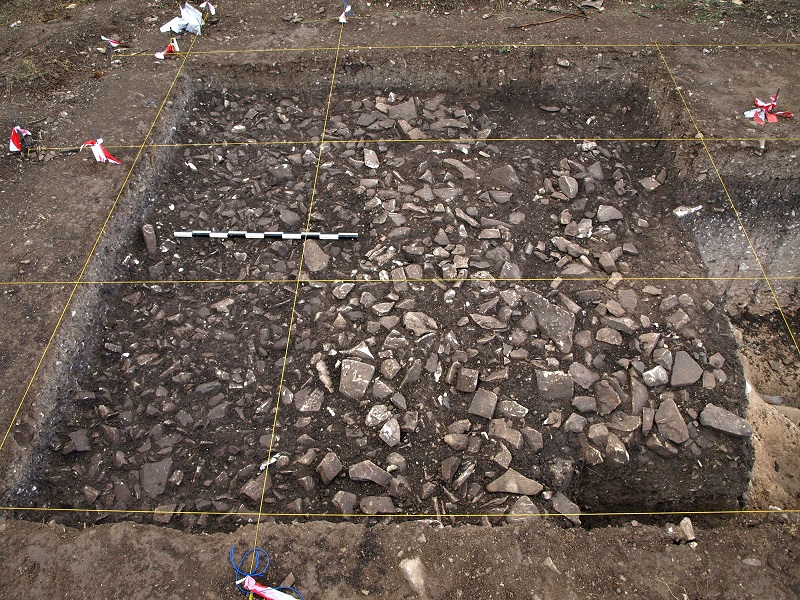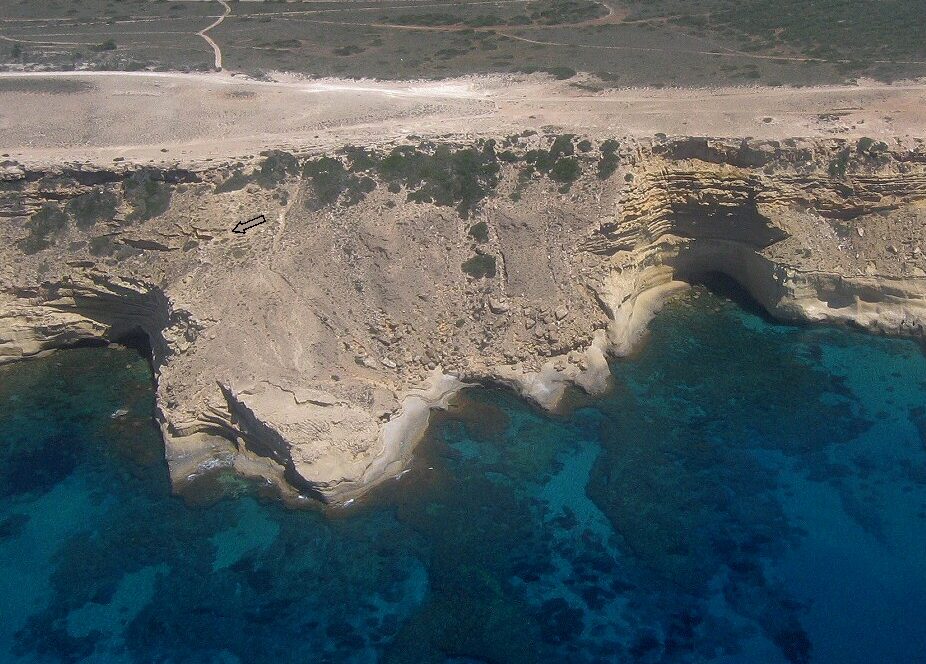“Despite the existence on the adjacent mainland of cultures of the Old Stone Age (Palaeolithic), remains of this very early phase have not so far been discovered in Cyprus” [Ian Todd, 1989]. This was said by Ian Todd in 1989 and still remains a fact in Cyprus in 2021. According to Simmons (2013), “for the time being, it appears that there were no Neanderthals exploring Cyprus” [Alan Simmons, 2013].
On the contrary, the myth linking the absence of connection between the late Pleistocene fauna and people living on Mediterranean islands is stressed by Simmons: “Archaeologists working in the Mediterranean traditionally have believed that islands, including Cyprus, were first inhabited by humans relatively late, during the Neolithic period around 6,500–7,000 BC (Cherry 1990; Le Brun et al. 1987). Researchers also believed that when these early colonists arrived, they did not encounter any of the islands’ unique native mammals, such as pygmy hippopotamus or dwarf elephants. These island-adapted species were felt to have gone extinct long before the arrival of humans, probably as a result of deteriorating climatic conditions. Recent multidisciplinary excavations on the Akrotiri Peninsula along the southern coast of Cyprus at Akrotiri Aetokremnos – or “Vulture Cliff” in Greek – have challenged these traditional scenarios” [Alan Simmons, 2001].
The deliberate introduction of wild boars, mice, cats, goats, sheep, cattle, dogs and deers in Epipaleolithic Cyprus by colonists
Sudying Epipaleolithic Cyprus, according to Vigne, Carrere, Briois and Guilaine (2011) suids [small wild boars], cats, goats, cattle, and dogs were living in Cyprus before or starting from the earliest phase at Shillourokambos, as they were deliberately introduced in Cyprus by humans somehow – and did not pre-exist. More precisely, the small wild boar was introduced in Cyprus during the Late Natufian or Early Khiamian culture (this means between 12,000-9,500 BC). According to Helmer (2008), the bezoar goats of the era were significantly smaller in size than the domestic goats we have today, as they evolved in size, in time and according to Vigne, Carrere, Briois and Guilaine, they were already domestic when they were introduced around 8,500 BC or later; “sheep were introduced up to 5 centuries later than goats in the form of small, horn-modified domestic animals”. Foxes were introduced in Cyprus “at the beginning of the tenth millennium BP [before present, 8,000 BC]” to control the population of mice, just as cats were supposed to do; dogs were already in Cyprus at 9,000 BC or earlier, as they “probably played a role in autochthonous-wild-boar hunting or control”; “Cattle were introduced to Cyprus ca. 10,300 cal BP [8,300 BC] or shortly before”; the small, Cypriot, fallow deer is assumed that it was introduced after 9,000 BC [Jean-Denis Vigne, Isabelle Carrere, Francois Briois, JeanGuilaine, 2011].
Vigne, Carrere, Briois and Guilaine’s (2011) assumption that “the house mouse and the cat were introduced to Cyprus in the middle of the eleventh millennium [Before Present, around 8,500 BC] at the latest, and the probably unintentional transport of the former possibly led to the introduction of its predator” fell through as cat bones were discovered at the site where they dug themselves [Briois and Vigne] 5 years later, and this was Agios Tychonas-Klimonas in 2016, which dates from 9,200 to 8,600 BC.
Vretsia-Roudias [10,000 – 6,500 BC], the oldest site in Cyprus
This place, which is the oldest that has been excavated so far in Cyprus, was according to Efstratiou (2011) a place of persistent visit and perhaps the temporary residence of hunting and foraging teams, throughout the early history of Cyprus, from the 10th millennium BC and until the middle of the 7th millennium BC [Cyprus Department of Antiquities].
The “stone structure” – An enigmatic finding
According to Efstratiou (2014), an early “stone structure” was unearthed, perhaps for the first time in Cyprus in undisturbed layers of the early Holocene. In this stone construction, many small stones placed next to each other – giving the image of cobblestone. Also, concentrations of large slabs in a horizontal and vertical position that appear to form a kind of construction that is at a slightly higher level than that of “stone structure” were unearthed. Another interesting development was the discovery of a second layer of stone that appeared after the removal of part of the “stone structure” in one of the squares. All this shows that there are different phases (at least three) of construction and use of stone surfaces and structures, the extent and boundaries of which are still undiagnosed. On the surface of the stone structure, but also inside it and probably in second use, thousands of stone tools were found – rounded and broken stones by high temperature – pieces of flint raw material and fragile bones such as those of wild pigs. The tools include millstones, choppers, tool cores and many more [Cyprus Department of Antiquities].

Evidence of wild pigs existence in Epipaleolithic Cyprus
At the site, there were discovered bones belonging to wild pigs [Cyprus Department of Antiquities] that match with the claim of Vigne, Carrere, Briois and Guilaine that this species could had been introduced in Cyprus during the Late Natufian or Early Khiamian culture [Jean-Denis Vigne, Isabelle Carrere, Francois Briois, JeanGuilaine, 2011].
The excavations at Vretsia-Roudias have not been concluded and detailed information regarding the finding is scarce. As soon as we learn more about this site, more information will be added to clarify if indeed precedes the Akrotiri-Aetokremnos site as it is speculated, especially following radiocarbon dating of bones and other material.
Akrotiri-Aetokremnos [9,940 – 9,640 BC]
An also early evidence of human occupation on the island has been found at the south end of the Akrotiri peninsula, where a small, collapsed, rock shelter eroded by the sea, named “Aetokremnos” (eagles’ cliff) about 60 meters above the Mediterranean Sea today, but at an unknown level above the sea 12,000 years earlier [Alan Simmons, 2013]. The site was eroding into the Mediterranean year by year […] [Alan Simmons, 2001]. It was utilized by a small group of hunting people, circa 10,000 BC, for a period of 300 years [Alan Simmons, 2013]; the origin of these inhabitants is unknown as their fate. According to Todd, the occupants of the shelter likely coexisted with the last remaining examples of the island’s Pleistocene fauna, especially the pygmy hippopotamus, and they may have been responsible for the extinction of the fauna [Ian Todd, 1989]. The weather conditions are the other alternative according to Simmons who also regards the hunters as the most possible reason for their extinction [Alan Simmons, 2013]. These people were essentially practising hunting (primarily) and gathering economy [Alan Simmons, 2001].

Extinct Pleistocene fauna and contemporary others found at Akrotiri-Aetokremnos
The inhabitants of the remote location of Akrotiri lived in the rock shelter, which appears today eroded by the sea. They were food foragers and prey hunters, and in their shelter were found the remains of 300,000 bones; of those, 98.3% belonged to 505 pygmy hippos Phanourios minutus and at least three dwarf elephant Elephas cypriotes, species that existed on the island and became extinct. Other fauna included over 70 birds, primarily great bustards, and over 70,000 shells representing over 20,000 individuals. “The presence of fallow deer (4 bones) and pig (13 bones) is puzzling” for Simmons since he reckons that these animals had been introduced in Cyprus only in the Neolithic period, and did not pre-exist on Cyprus [Alan Simmons, 2013].
Artefacts
According to Simmons, was an artefact assemblage exceeding 1,000 pieces of chipped stone. Of importance was that this assemblage did not resemble a typical Cypriot Neolithic assemblage. Rather, it would be perfectly at home in a mainland Late Epipaleolithic context [Alan Simmons, 2013].